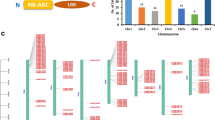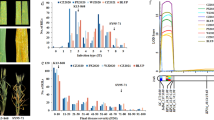Abstract
Several studies have reported markers linked to a putative resistance gene from Poncirus trifoliata (Ctv-R) located at linkage group 4 that confers resistance against one of the most important citrus pathogens, citrus tristeza virus (CTV). To be successful in both marker-assisted selection and transformation experiments, its accurate mapping is needed. Several factors may affect its localization, among them two are considered here: the definition of resistance and the genetic background of progeny.
Two progenies derived from P. trifoliata, by self-pollination and by crossing with sour orange (Citrus aurantium), a citrus rootstock well-adapted to arid and semi-arid areas, were used for linkage group-4 marker enrichment. Two new methodologies were used to enrich this region with expressed sequences. The enrichment of group 4 resulted in the fusion of several C. aurantium linkage groups. The new one A(7+3+4) is now saturated with 48 markers including expressed sequences. Surprisingly, sour orange was as resistant to the CTV isolate tested as was P. trifoliata, and three hybrids that carry Ctv-R, as deduced from its flanking markers, are susceptible to CTV. The new linkage maps were used to map Ctv-R under the hypothesis of monogenic inheritance. Its position on linkage group 4 of P. trifoliata differs from the location previously reported in other progenies. The genetic analysis of virus-plant interaction in the family derived from C. aurantium after a CTV chronic infection showed the segregation of five types of interaction, which is not compatible with the hypothesis of a single gene controlling resistance. Two major issues are discussed: another type of genetic analysis of CTV resistance is needed to avoid the assumption of monogenic inheritance, and transferring Ctv-R from P. trifoliata to sour orange might not avoid the CTV decline of sweet orange trees.





Similar content being viewed by others
References
Albiach-Martí MR, Grosser JW, Hilf ME, Gowda S, Mawassi M, Satyanarayana T, Garnsey SM, Dawson WO (1999) CTV resistant plants are not immune to CTV at the cellular level. Proc 18th Annual Meeting, American Society for Virology 192
Asins MJ (2002) Present and future of quantitative trait locus analysis in plant breeding. Plant Breed 121:281–291
Asins MJ, Bernet GP, Ruiz C, Cambra M, Guerri J, Carbonell EA. QTL analysis of citrus tristeza virus-citradia interaction. Theor Appl Genet: DOI 10.1007/s00122-003-1486-7
Baker B, Zambryski P, Staskawicz B, Dinesh-Kumar SP (1997) Signalling in plant-microbe interactions. Science 276:726–733
Bar-Joseph M, Che X, Piestun D, Botuman O, Gofman R, Ben Shalom Y, Yang G, Mawassi M (2003) Citrus tristeza virus biology revisited: quick decline and seedling yellows—the cost of the sour orange resistance gene(s). Proc Int Soc Citricult IX Congr 2000, pp 963–965
Bendahmane A, Kanyuka K, Baulcombe DC (1999) The Rx gene from potato controls separate virus resistance and cell death responses. Plant Cell 11:781–791
Bernet GP, Asíns MJ (2003) Identification and genomic distribution of gypsy-like retrotransposons in Citrus and Poncirus. Theor Appl Genet (in press)
Bretó MP, Ruiz C, Pina JA, Asins MJ (2001) The diversification of Citrus clementina Hort. ex Tan., a vegetatively propagated crop species. Mol Phylog Evol 21:285–293
Cambra M, Camarasa E, Gorris MT, Garnsey SM, Gumpf DJ, Tsai MC (1993) Epitope diversity of citrus tristeza virus isolates in Spain. In: Proc 12th Conf IOCV, Riverside, California, USA, pp 33–38
Costa AS, Grant TJ (1951) Studies on transmission of the tristeza virus by the vector Aphis citricidus. Phytopathology 41:105–113
Dawson TE, Mooney PA (2000) Evidence for trifoliate resistance braking isolates of citrus tristeza virus in New Zealand. 14th IOCV Conference, pp 69–76
Dawson WO, Hilf ME (1992) Host-range determinants of plant viruses. Annu Rev Plant Physiol Plant Mol Biol 43:527–555
Dellaporta SL, Wood J, Hicks JB (1983) A plant DNA minipreparation: version ii. Plant Mol Biol Rep 1:19–21
Deng Z, Huang S, Ling P, Chen C, Yu C, Weber CA, Moore GA, Gmitter FG (2000) Cloning and characterization of the NBS-LRR class resistance-gene candidate sequence in citrus. Theor Appl Genet 101:814–822
Deng Z, Tao Q, Chang YL, Huang S, Ling P, Yu C, Chen C, Gmitter FG, Zhang HB (2001) Construction of a bacterial artificial chromosome (BAC) library for citrus and identification of BAC contigs containing resistance-gene candidates. Theor Appl Genet 102:1177–1184
Fang DQ, Roose ML (1999) A novel gene conferring citrus tristeza virus resistance in Citrus maxima (Burm.) Merrill. HortScience 34:334–335
Fang DQ, Federici CT, Roose ML (1998) A high-resolution linkage map of the Citrus Tristeza virus resistance gene region in Poncirus trifoliata (L.) Raf. Genetics 150:883–890
Garnsey M (1999) Systemic diseases. In: Timmer LW, Duncan LW (eds) Citrus health management. Plant Health Management Series. APS Press. The American Phytopathological Society, pp 95–106
Garnsey SM, Pemar TA, Cambra M, Henderson CT (1993) Direct tissue-blot immunoassay (DTBIA) for detection of citrus tristeza virus (CTV). In Moreno P, Da Graça JV, Timmer LW (eds) Proc 12th Conf Int Organiz Citrus Virol IOCV, Riverside, California, pp 39–50
Glazebrook J (2001) Genes controlling expression of defense responses in Arabidopsis—2001 status. Curr Opin Plant Biol 4:301–308
Glazebrook J, Rogers EE, Ausubel FM (1997) Use of Arabidopsis for genetic dissection of plant defense responses. Annu Rev Genet 31:547–569
Gmitter FG, Xiao SY, Huang S, Hu XL, Garnsey SM, Deng Z (1996) A localized linkage map of the citrus tristeza virus resistance gene region. Theor Appl Genet 92:688–695
Grube RC, Blauth JR, Arnedo MS, Caranta C, Jahn MK (2000) Identification and comparative mapping of a dominant potyvirus resistance gene cluster in Capsicum. Theor Appl Genet 101:852–859
Hammond-Kosack K, Jones JDG (1997) Plant disease resistance genes. Annu Rev Plant Physiol Plant Mol Biol 48:575–607
Karasev AV (2000) Genetic diversity and evolution of closteroviruses. Annu Rev Phytopathol 38:293–324
Ling P, Duncan LW, Deng Z, Dunn D, Xu X, Huang S, Gmitter FG (2000) Inheritance of citrus nematode resistance and its linkage with molecular markers. Theor Appl Genet 101:1010–1017
Mago R, Nair S, Mohan M (1999) Resistance gene analogues from rice: cloning, sequencing and mapping. Theor Appl Genet 99:50–57
Menge JA (2000) Bacterial diseases. Blast and Black Pit. In: Timmer LW, Garnsey SM, Graham JH (eds) Compendium of citrus diseases. APS Press. The American Phytopathological Society, St Paul, Minnesota, 5 pp
Mestre PF, Asins MJ, Pina JA, Carbonell EA, Navarro L (1997a) Molecular markers flanking citrus tristeza virus resistance gene from Poncirus trifoliata (L.) Raf. Theor Appl Genet 94:458–464
Mestre PF, Asins MJ, Carbonell EA, Navarro L (1997b) New gene(s) involved in the resistance of Poncirus trifoliata (L.) Raf. to citrus tristeza virus. Theor Appl Genet 95:691–695
Mestre PF, Asins MJ, Pina JA, Navarro L (1997c) Efficient search for new resistant genotypes to the citrus tristeza closterovirus in the orange subfamily Aurantioideae. Theor Appl Genet 95:1282–1288
Michelmore RW, Paran I, Kesseli RV (1991) Identification of markers linked to disease resistance genes by bulked segreganting analysis: a rapid method to detect markers in specific genomic regions using segregant populations. Proc Natl Acad Sci USA 88:9828–9832
Ponstein AS, Bres-Vloemans SA, Sela-Buurlage MB, van der Voort JR, Melchinger AE, Cottet A (1994) A novel pathogen- and wound-inducible tobacco (Nicotiana tabacum) protein with antifungal activity. Plant Physiol 104:109–118
Pysh LD, Wysocka-Diller JW, Camilleri C, Bouchez D, Benfey PN (1999) The GRAS gene family in Arabidopsis: sequence characterization and basic expression analysis of SCARECROW-LIKE genes. Plant J 18:111–119
Richter TE, Ronald PC (2000) The evolution of disease resistance genes. Plant Mol Biol 42:195–204
Roossinck MJ (1997) Mechanisms of plant virus evolution. Annu Rev Phytopathol 35:191–209
Ruiz C, Asíns MJ (2003) Comparison between Poncirus and Citrus genetic linkage maps. Theor Appl Genet 106:826–836
Solomon-Blackburn R, Barker H (2001) Breeding virus-resistant potatoes (Solanum tuberosum): a review of traditional and molecular approaches. Heredity 86:17–35
Stanford A, Bevan M, Northcote D (1989) Differential expression within a family of novel wound-induced genes in potato. Mol Gen Genet 215, 200–208
Van der Vossen EG, van der Voort JR, Kanyuka K, Bendahmane A, Sandbrink H, Baulcombe DC, Bakker J, Stiekema WJ, Klein-Lankhorst RM (2000) Homologues of a single resistance-gene cluster in potato confer resistance to distinct pathogens: a virus and a nematode. Plant J 23:567–576
Van Ooijen JW, Voorips RE (2001) JoinMap 3.0, Software for the calculation of genetic linkage maps. Plant Research International, Wageningen, The Netherlands
Vance V, Vaucheret H (2001) RNA silencing in plants—Defense and counterdefense. Science 292:2277–2280
Yang Z-N, Ye X-R, Choi S, Molina J, Moonan F, Wing RA, Roose ML, Mirkov TE (2001) Construction of a 1.2-Mb contig including the cistrus tristeza virus resistance gene locus using a bacterial artificial chromosome library of Poncirus trifoliata (L.) Raf. Genome 44:382–393
Yang Z-N, Ye X-R, Molina J, Roose ML, Mirkov TE (2003) Sequence analysis of a 282-kilobase region surrounding the citrus tristeza virus resistance gene (Ctv)-locus in Poncirus trifoliata L. Raf. Plant Physiol 131:482–492
Yoshida T, ShichijoT, Ueno I, Kihara T, Yamada Y, Hirai M, Yamada S, Leki H, Kuramoto T (1983) Survey for resistance of citrus cultivars and hybrid seedlings to citrus tristeza virus (CTV). Bull Fruit Tree Res Stn B B 10:51–68
Acknowledgments
This work has been carried out in compliance with the current Spanish laws governing genetic experimentation, and was supported in part by grants from the Conselleria de Cultura, Educació i Ciència (GPB and MPB), INIA (SC99–047) MCYT (AGL2002–02395) and IVIA (4306). The authors wish to thank M. T. Gorris, J. Puchades, J. Piquer and Dr. C. Ruiz for their technical assistance. The authors thank Drs. P. Moreno and. M. Cambra for helpful and clarifying comments on CTV and for establishing and maintaining the bank of CTV isolates.
Author information
Authors and Affiliations
Corresponding author
Additional information
Communicated by C. Möllers
Rights and permissions
About this article
Cite this article
Bernet, G.P., Bretó, M.P. & Asins, M.J. Expressed sequence enrichment for candidate gene analysis of citrus tristeza virus resistance. Theor Appl Genet 108, 592–602 (2004). https://doi.org/10.1007/s00122-003-1479-6
Received:
Accepted:
Published:
Issue Date:
DOI: https://doi.org/10.1007/s00122-003-1479-6




